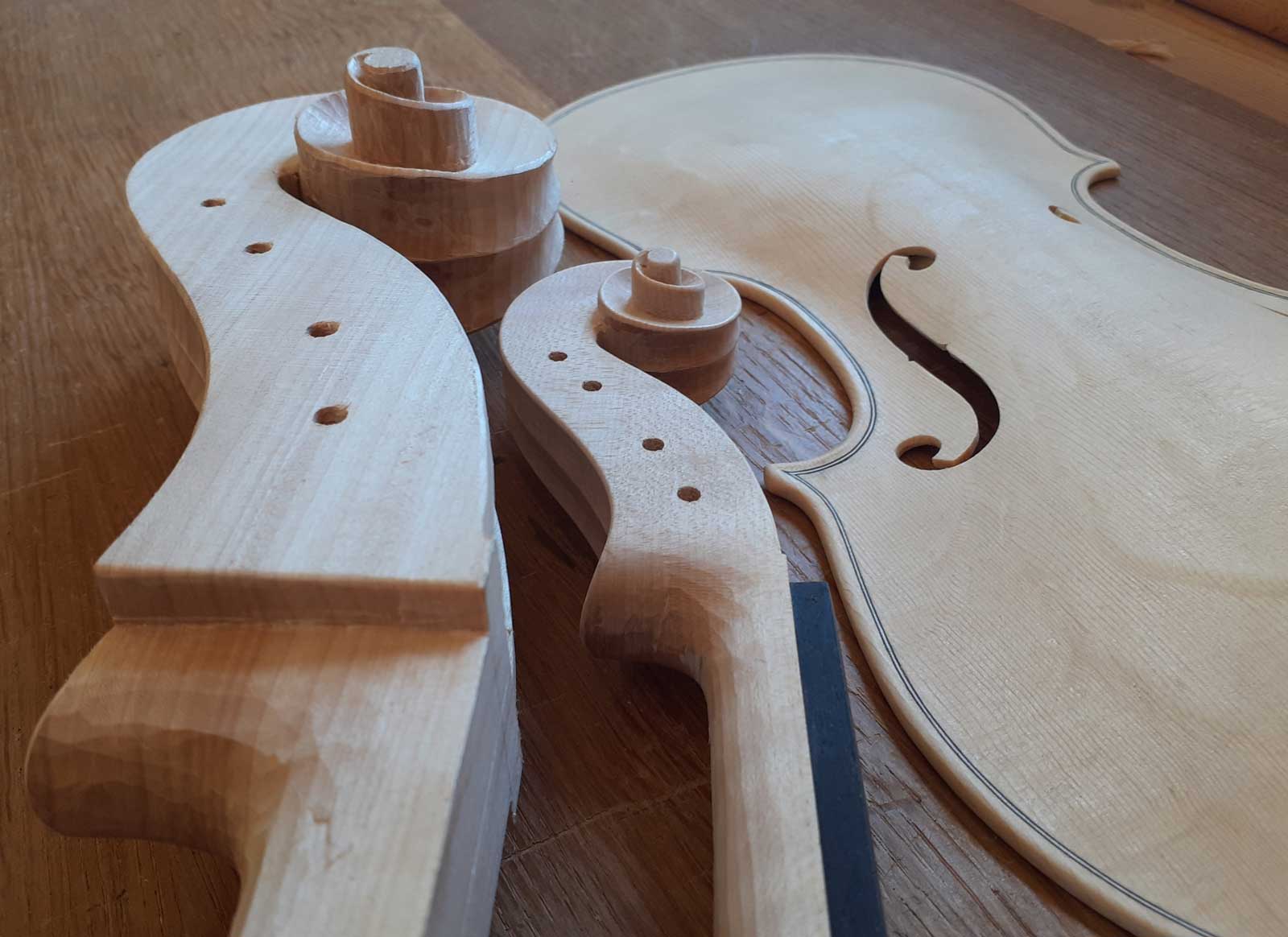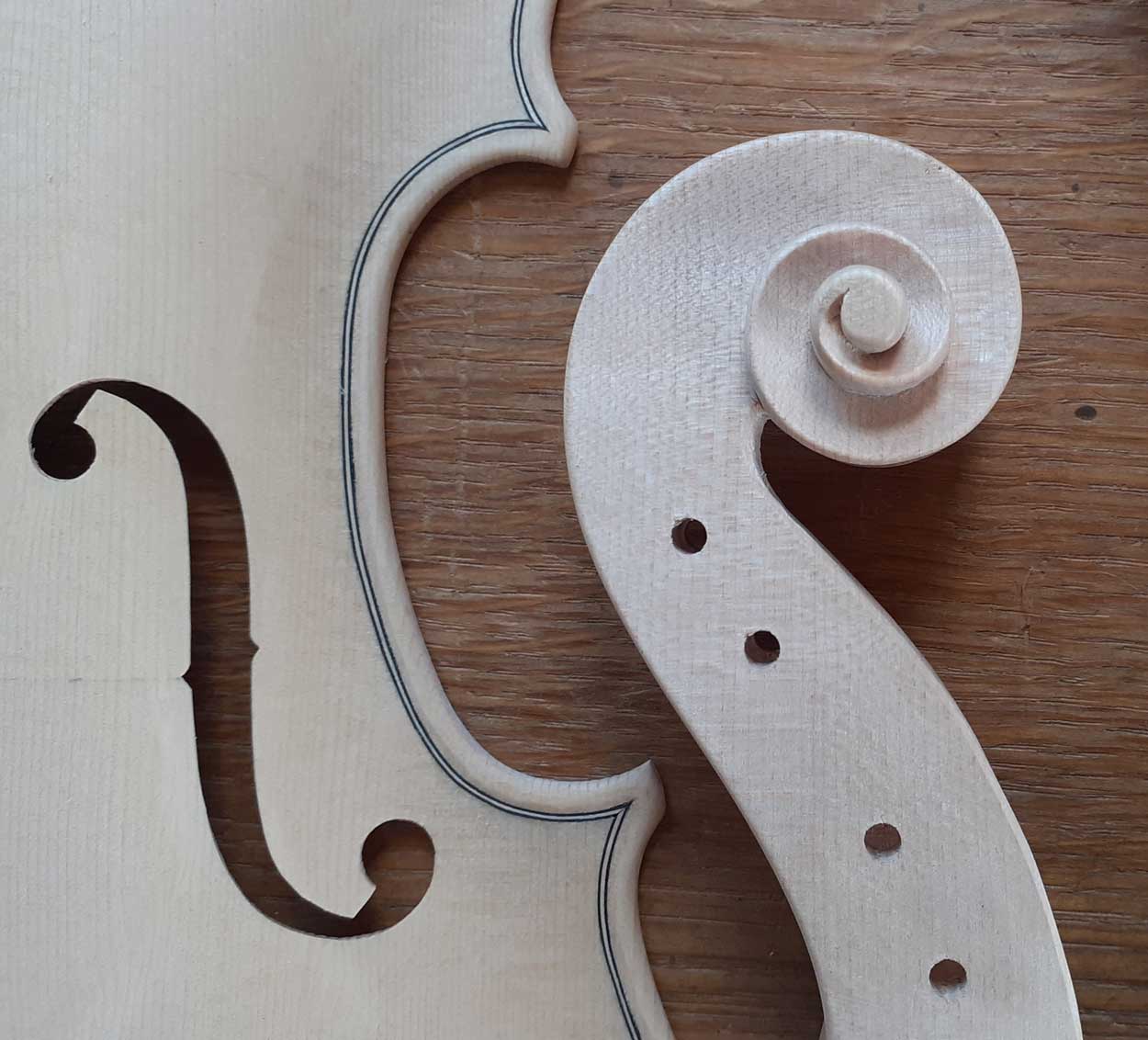Opposites don’t neccessarily detract!
MAY 2022

A month ago, I spent a few days making with a group of other violin makers, sometimes working on a joint project as well as working on my own work. Before the week started, I had just finished the violin I was making, so quickly looked out the scroll block for the cello I was about to start. The cello, like the original I use as a model, was to be made of poplar rather than maple, a fairly common material for cellos in 17th and 18th century Cremona. My previous cello was also this model, also in poplar, and I particularly liked it, both visually and in the warmer sound. I was only going to be three days at the joint making venture, and for the first day and most of the second I worked on the shared instrument.
Then in the afternoon I started my scroll which had already been sawn out in profile. I cleaned up the outline with chisel, gouge and files, marked the centre line and drew on the sides of the pegbox and the outside turn of the scroll and just had enough time to start removing wood from the outside of the pegbox. But the next morning, I noticed that the wood was flexing under the tools, flexing too much. Poplar wood varies quite considerably, it can be light and soft or moderately heavy and harder, and as I removed the wood, it became ever more obvious that this piece was not substantial enough to withstand the pressure of the strings. One of my colleagues suggested I could graft on a stiffer neck, but I would probably have to bush the peg holes too. Grafting a neck is not something I have done for over thirty years, and is not particularly fun either, so I decided to make another neck for the cello. But what was I going to do for the rest of the day? It took me a couple of minutes to decide, finish the scroll that day, put away the photos and just follow the templet and my own conception, which, after making many of this model, would hopefully not be too different from Andrea Guarneri!
The softness of the wood helped, as did the freedom from knowing this would not end up on an instrument, but by the end of the day the scroll was done, except the pegbox which will remain only slightly hollowed out inside, just to give a suggestion of how it should be. It now resides as in our dining room as an ‘object d’art’ or a testament to failure, depending on your point of view, but it does look like a Andrea Guarneri scroll!
Since then, the cello making has been put on hold, as I had the opportunity to borrow a Gofriller violin to copy. In shape and style, it is quite different from my usual instruments, but it is a lovely instrument typical of the Venetian maker. So for this instrument I have been working in a very different way, copying everything as close as I can, and when I am not sure how a particular aspect should be, there is always the original violin to look at. This slowed the making process, but it is fantastic for looking, for questioning, for developing. Now all the pieces are finished except for fitting the neck, it looks like a Gofriller would have looked back around 1700, but not especially like one of my instruments, which is the whole point of copying.
And therein lies a question that violin makers ask, whether, as has been done for two hundred years or more, to copy good old instruments or to develop your own style? There isn’t a right answer, but now that I have more than a few years under my belt, when I look back at the instruments I have made, there is definitely a William Castle style in how they look, and I know there is a similarity in sound too. Developing that style has not been a conscious ten- or thirty-year plan, but has been a process of choosing and making the models I like, one by one, sometimes, especially with violas, modifying those models for reasons of sound and playability, and deciding whether I am going to copy certain features, or, for my own reasons, not to. So although the approach in these last two projects has been very different, they have both contributed to the bigger picture; copying the Gofriller has taught me something, particularly about archings and edgework, and the cello scroll has shown me that I can trust my own judgement.
